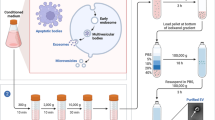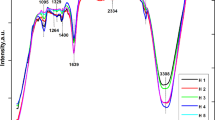Abstract
Purpose of Review
Exosomes are membrane vesicles that are released by most cell types into the extracellular environment. The purpose of this article is to discuss the main morphological features and contents of bone-derived exosomes, as well as their major isolation and physical characterization techniques. Furthermore, we present various scenarios and discuss potential clinical applications of bone-derived exosomes in bone repair and regeneration.
Recent Findings
Exosomes were believed to be nanosized vesicles derived from the multivesicular body. Reports now suggest that nanovesicles could bud directly from the plasma membrane. However, the exosome cargo is cell-type specific and is derived from the parent cell. In the bone matrix, several intracellular proteins lacking a signal peptide are transported to the ECM by exosomes. Besides proteins, several mRNA, miRNA, and lipids are exported to the ECM by bone cells and bone marrow stromal cells. Recent evidence suggests that several of the functional components in the cargo could regulate processes of bone formation, inhibit osteoclast activity, and promote fracture repair.
Summary
Exosomes are powerful cellular molecular machines produced without human intervention and packaged with physiological cargo that could be utilized for molecular therapy in several skeletal disorders such as osteoporosis, osteogenesis imperfecta, and fracture healing. Although much work has been done, there is a lot of information that is still unknown, as exosomes contain a multitude of molecules whose identity and function have yet to be identified.


Similar content being viewed by others
References
Papers of particular interest, published recently, have been highlighted as: • Of importance
• Yáñez-Mó M, Siljander PR-M, Andreu Z, Zavec AB, Borràs FE, Buzas EI, et al. Biological properties of extracellular vesicles and their physiological functions. J Extracell Vesicles. 2015;4:27066. https://doi.org/10.3402/jev.v4.27066. This study is a good overview of the characterization and identification of the contents of extracellular vesicles and the biological function of these vesicles.
Raposo G, Stoorvogel W. Extracellular vesicles: exosomes, microvesicles, and friends. J Cell Biol. 2013;200(4):373–83. https://doi.org/10.1083/jcb.201211138.
Shapiro IM, Landis WJ, Risbud MV. Matrix vesicles: are they anchored exosomes? Bone. 2015;79:29–36. https://doi.org/10.1016/j.bone.2015.05.013.
Keller S, Ridinger J, Rupp A-K, Janssen JW, Altevogt P. Body fluid derived exosomes as a novel template for clinical diagnostics. J Transl Med. 2011;9(1):86. https://doi.org/10.1186/1479-5876-9-86.
Lässer C, Seyed Alikhani V, Ekström K, Eldh M, Torregrosa Paredes P, Bossios A, et al. Human saliva, plasma and breast milk exosomes contain RNA: uptake by macrophages. J Transl Med. 2011;9(1):9. https://doi.org/10.1186/1479-5876-9-9.
Edgar JR. Q&A: what are exosomes, exactly? BMC Biol. 2016;14(1):46. https://doi.org/10.1186/s12915-016-0268-z.
Avcı E, Edibe Avcı BS, Banu Balcı-Peynircioğlu P. An overview of exosomes: from biology to emerging roles in immune response. Acta Med Austriaca. 2015;47:2–10.
Vlassov AV, Magdaleno S, Setterquist R, Conrad R. Exosomes: current knowledge of their composition, biological functions, and diagnostic and therapeutic potentials. Biochim Biophys Acta BBA - Gen Subj. 2012;1820(7):940–8. https://doi.org/10.1016/j.bbagen.2012.03.017.
Qin Y, Sun R, Wu C, Wang L, Zhang C. Exosome: a novel approach to stimulate bone regeneration through regulation of osteogenesis and angiogenesis. Int J Mol Sci. 2016;17(5):712. https://doi.org/10.3390/ijms17050712.
Xie Y, Chen Y, Zhang L, Ge W, Tang P. The roles of bone-derived exosomes and exosomal microRNAs in regulating bone remodelling. J Cell Mol Med. 2017;21(5):1033–41. https://doi.org/10.1111/jcmm.13039.
Fleming A, Sampey G, Chung MC, Bailey C, Hoek V, Kashanchi MLF, et al. The carrying pigeons of the cell: exosomes and their role in infectious diseases caused by human pathogens. Pathog Dis. 2014;71:109–20. https://doi.org/10.1111/2049-632X.12135.
Gibbons D Stem cell stories that caught our eye: our earliest days, cell therapy without the cells and unproven therapies. Stem Cellar. 2015. https://blog.cirm.ca.gov/2015/09/04/stem-cell-stories-that-caught-our-eye-our-earliest-days-cell-therapy-without-the-cells-and-unproven-therapies/. Accessed 20 Sept 2017.
Narayanan R, Huang C-C, Ravindran S. Hijacking the cellular mail: exosome mediated differentiation of mesenchymal stem cells. Stem Cells Int. 2016;2016:1–11. https://doi.org/10.1155/2016/3808674.
Li P, Kaslan M, Lee SH, Yao J, Gao Z. Progress in exosome isolation techniques. Theranostics. 2017;7(3):789–804. https://doi.org/10.7150/thno.18133.
Zeringer E, Barta T, Li M, Vlassov AV. Strategies for isolation of exosomes. Cold Spring Harb Protoc 2015;2015(4) pdb.top074476. https://doi.org/10.1101/pdb.top074476.
Baranyai T, Herczeg K, Onódi Z, Voszka I, Módos K, Marton N, et al. Isolation of exosomes from blood plasma: qualitative and quantitative comparison of ultracentrifugation and size exclusion chromatography methods. PLoS One. 2015;10(12):e0145686. https://doi.org/10.1371/journal.pone.0145686.
Momen-Heravi F, Balaj L, Alian S, Mantel P-Y, Halleck AE, Trachtenberg AJ, et al. Current methods for the isolation of extracellular vesicles. Biol Chem. 2013;394(10):1253–62. https://doi.org/10.1515/hsz-2013-0141.
Nakano M, Nagaishi K, Konari N, Saito Y, Chikenji T, Mizue Y, et al. Bone marrow-derived mesenchymal stem cells improve diabetes-induced cognitive impairment by exosome transfer into damaged neurons and astrocytes. Sci Rep. 2016;6(24805):1–14. https://doi.org/10.1038/srep24805.
Li D, Liu J, Guo B, Liang C, Dang L, Lu C, et al. Osteoclast-derived exosomal miR-214-3p inhibits osteoblastic bone formation. Nat Commun. 2016;7:10872. https://doi.org/10.1038/ncomms10872.
Rager TM, Olson JK, Zhou Y, Wang Y, Besner GE. Exosomes secreted from bone marrow-derived mesenchymal stem cells protect the intestines from experimental necrotizing enterocolitis. J Pediatr Surg. 2016;51(6):942–7. https://doi.org/10.1016/j.jpedsurg.2016.02.061.
Xu J-F, Yang G, Pan X-H, Zhang S-J, Zhao C, Qiu B-S, et al. Altered microRNA expression profile in exosomes during osteogenic differentiation of human bone marrow-derived mesenchymal stem cells. PLoS One. 2014;9(12):e114627. https://doi.org/10.1371/journal.pone.0114627.
Ge M, Wu Y, Ke R, Cai T, Yang J, Mu X. Value of osteoblast-derived exosomes in bone diseases. J Craniofac Surg. 2017; 28(4): 866–70. https://doi.org/10.1097/SCS.0000000000003463.
Marton N, Kovács OT, Baricza E, Kittel Á, Győri D, Mócsai A, Meier FMP, Goodyear CS, McInnes IB, Buzás EI, Nagy G. Extracellular vesicles regulate the human osteoclastogenesis: divergent roles in discrete inflammatory arthropathies. Cell Mol Life Sci. 2017;74(19):3599–611. https://doi.org/10.1007/s00018-017-2535-8.
• Lu Z, Chen Y, Dunstan C, Roohani-Esfahani S, Zreiqat H. Priming adipose stem cells with tumor necrosis factor-alpha preconditioning potentiates their exosome efficacy for bone regeneration. Tissue Eng Part A. 2017; https://doi.org/10.1089/ten.tea.2016.0548. This paper presents new information on the use of exosomes in bone regeneration.
Sun W, Zhao C, Li Y, Wang L, Nie G, Peng J, et al. Osteoclast-derived microRNA-containing exosomes selectively inhibit osteoblast activity. Cell Discov. 2016;2:201615. https://doi.org/10.1038/celldisc.2016.15.
Zhang J, Liu X, Li H, Chen C, Hu B, Niu X, et al. Exosomes/tricalcium phosphate combination scaffolds can enhance bone regeneration by activating the PI3K/Akt signaling pathway. Stem Cell Res Ther. 2016;7(1):136. https://doi.org/10.1186/s13287-016-0391-3.
Zhu W, Huang L, Li Y, Zhang X, Gu J, Yan Y, et al. Exosomes derived from human bone marrow mesenchymal stem cells promote tumor growth in vivo. Cancer Lett. 2012;315(1):28–37. https://doi.org/10.1016/j.canlet.2011.10.002.
Xu S, Wang Z. Bone marrow mesenchymal stem cell-derived exosomes enhance osteoclastogenesis during alveolar bone deterioration in rats. RSC Adv. 2017;7(34):21153–63. https://doi.org/10.1039/C6RA27931G.
Wang J, Hendrix A, Hernot S, Lemaire M, Bruyne ED, Valckenborgh EV, et al. Bone marrow stromal cell–derived exosomes as communicators in drug resistance in multiple myeloma cells. Blood. 2014;124(4):555–66. https://doi.org/10.1182/blood-2014-03-562439.
• Cui Y, Luan J, Li H, Zhou X, Han J. Exosomes derived from mineralizing osteoblasts promote ST2 cell osteogenic differentiation by alteration of microRNA expression. FEBS Lett. 2016;590(1):185–92. https://doi.org/10.1002/1873-3468.12024. This study identifies the presence of several novel miRNAs in the exosomes and their role in osteoblast differentiation.
Huang C-C, Narayanan R, Alapati S, Ravindran S. Exosomes as biomimetic tools for stem cell differentiation: applications in dental pulp tissue regeneration. Biomaterials. 2016;111:103–15. https://doi.org/10.1016/j.biomaterials.2016.09.029.
Ge M, Ke R, Cai T, Yang J, Mu X. Identification and proteomic analysis of osteoblast-derived exosomes. Biochem Biophys Res Commun. 2015;467(1):27–32. https://doi.org/10.1016/j.bbrc.2015.09.135.
Zhang Y, Song Y, Ravindran S, Gao Q, Huang CC, Ramachandran A, et al. DSPP contains an IRES element responsible for the translation of dentin phosphophoryn. J Dent Res. 2014;93(2):155–61. https://doi.org/10.1177/0022034513516631.
Kolhe R, Hunter M, Liu S, Jadeja RN, Pundkar C, Mondal AK, et al. Gender-specific differential expression of exosomal miRNA in synovial fluid of patients with osteoarthritis. Sci Rep. 2017;7(1):2029. https://doi.org/10.1038/s41598-017-01905-y.
Haraszti RA, Didiot M-C, Sapp E, Leszyk J, Shaffer SA, Rockwell HE, et al. High-resolution proteomic and lipidomic analysis of exosomes and microvesicles from different cell sources. J Extracell Vesicles. 2016;5(1):32570. https://doi.org/10.3402/jev.v5.32570.
Colombo M, Raposo G, Théry C. Biogenesis, secretion, and intercellular interactions of exosomes and other extracellular vesicles. Annu Rev Cell Dev Biol. 2014;30(1):255–89. https://doi.org/10.1146/annurev-cellbio-101512-122326.
Théry C, Zitvogel L, Amigorena S. Exosomes: composition, biogenesis and function. Nat Rev Immunol. 2002;2(8):569–79. https://doi.org/10.1038/nri855.
Ravindran S, Narayanan K, Eapen AS, Hao J, Ramachandran A, Blond S, et al. Endoplasmic reticulum chaperone protein GRP-78 mediates endocytosis of dentin matrix protein 1. J Biol Chem. 2008;283(44):29658–70. https://doi.org/10.1074/jbc.M800786200.
Ramachandran A, Ravindran S, Huang C-C, George A. TGF beta receptor II interacting protein-1, an intracellular protein has an extracellular role as a modulator of matrix mineralization. Sci Rep. 2016;6(37885):1–16. https://doi.org/10.1038/srep37885.
Ekström K, Omar O, Granéli C, Wang X, Vazirisani F, Thomsen P. Monocyte exosomes stimulate the osteogenic gene expression of mesenchymal stem cells. PLoS One. 2013;8(9):e75227. https://doi.org/10.1371/journal.pone.0075227.
Bruno S, Grange C, Deregibus MC, Calogero RA, Saviozzi S, Collino F, et al. Mesenchymal stem cell-derived microvesicles protect against acute tubular injury. J Am Soc Nephrol. 2009;20(5):1053–67. https://doi.org/10.1681/ASN.2008070798.
Herrera MB, Fonsato V, Gatti S, Deregibus MC, Sordi A, Cantarella D, et al. Human liver stem cell-derived microvesicles accelerate hepatic regeneration in hepatectomized rats. J Cell Mol Med. 2010;14(6B):1605–18. https://doi.org/10.1111/j.1582-4934.2009.00860.x.
Li J, Liu K, Liu Y, Xu Y, Zhang F, Yang H, et al. Exosomes mediate the cell-to-cell transmission of IFN-α-induced antiviral activity. Nat Immunol. 2013;14(8):793–803. https://doi.org/10.1038/ni.2647.
Gimona M, Pachler K, Laner-Plamberger S, Schallmoser K, Rohde E. Manufacturing of human extracellular vesicle-based therapeutics for clinical use. Int J Mol Sci. 2017;18(6):1190. https://doi.org/10.3390/ijms18061190.
Burke J, Kolhe R, Hunter M, Isales C, Hamrick M, Fulzele S. Stem cell-derived exosomes: a potential alternative therapeutic agent in orthopaedics. Stem Cells Int. 2016;2016:1–6. https://doi.org/10.1155/2016/5802529.
Furuta T, Miyaki S, Ishitobi H, Ogura T, Kato Y, Kamei N, et al. Mesenchymal stem cell-derived exosomes promote fracture healing in a mouse model. Stem Cells Transl Med. 2016;5(12):1620–30. https://doi.org/10.5966/sctm.2015-0285.
Wei J, Li H, Wang S, Li T, Fan J, Liang X, et al. Let-7 enhances osteogenesis and bone formation while repressing adipogenesis of human stromal/mesenchymal stem cells by regulating HMGA2. Stem Cells Dev. 2014;23(13):1452–63. https://doi.org/10.1089/scd.2013.0600.
Zhang Y, Xie R-L, Croce CM, Stein JL, Lian JB, van Wijnen AJ, et al. A program of microRNAs controls osteogenic lineage progression by targeting transcription factor Runx2. Proc Natl Acad Sci U S A. 2011;108(24):9863–8. https://doi.org/10.1073/pnas.1018493108.
Qi X, Zhang J, Yuan H, Xu Z, Li Q, Niu X, et al. Exosomes secreted by human-induced pluripotent stem cell-derived mesenchymal stem cells repair critical-sized bone defects through enhanced angiogenesis and osteogenesis in osteoporotic rats. Int J Biol Sci. 2016;12(7):836–49. https://doi.org/10.7150/ijbs.14809.
Zhang S, Chu WC, Lai RC, Lim SK, Hui JHP, Toh WS. Exosomes derived from human embryonic mesenchymal stem cells promote osteochondral regeneration. Osteoarthr Cartil. 2016;24(12):2135–40. https://doi.org/10.1016/j.joca.2016.06.022.
Acknowledgements
A. P greatly acknowledges the scholarship from the Rosztoczy Foundation.
Funding
This work was supported by the Brodie Endowment Fund and the National Institutes of Health grant DE11657.
Author information
Authors and Affiliations
Corresponding author
Ethics declarations
Conflict of Interest
Adrienn Pethő, Yinghua Chen, and Anne George declare no conflict of interest.
Human and Animal Rights and Informed Consent
This article does not contain any studies with human or animal subjects performed by any of the authors.
Additional information
This article is part of the Topical Collection on Skeletal Development
Rights and permissions
About this article
Cite this article
Pethő, A., Chen, Y. & George, A. Exosomes in Extracellular Matrix Bone Biology. Curr Osteoporos Rep 16, 58–64 (2018). https://doi.org/10.1007/s11914-018-0419-y
Published:
Issue Date:
DOI: https://doi.org/10.1007/s11914-018-0419-y




